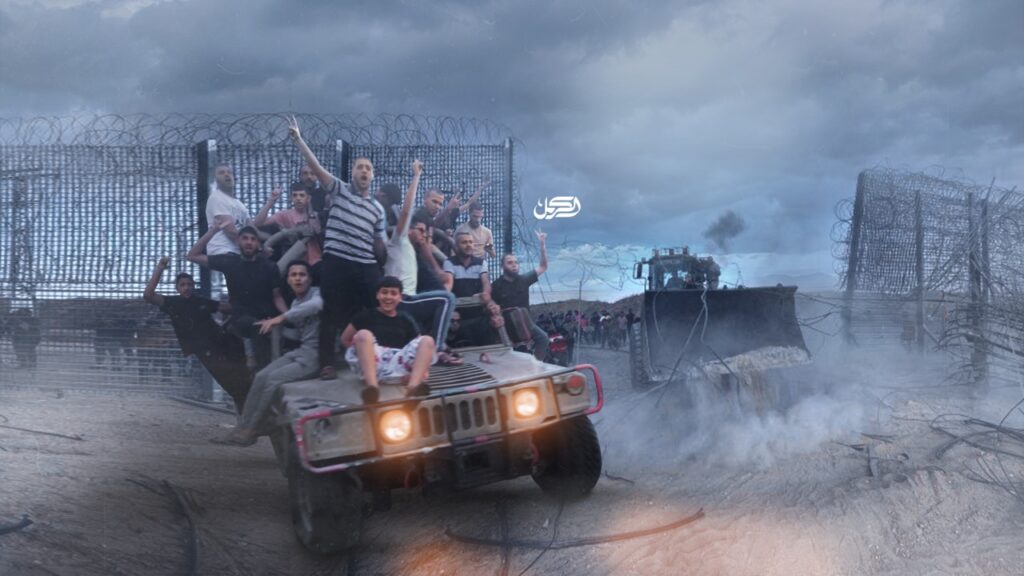"… The Al-Aqsa Flood battle will be remembered as a major turning point in the history of the Arab-Zionist conflict. It is a huge blow to Israeli deterrence, Israeli national security, the image of the Israeli army, and the confidence of the settlers in their army. It is a blow to the image of “Israel” as a permanent stronghold in our Arab lands which reactionary regimes can turn to for protection and prosperity. It is a blow to normalization projects in the region, those already signed and those yet to be signed.
The occupation has declared war on the resistance in Gaza. It says the goal is to eliminate the Hamas and Islamic Jihad movements.
At the same time, the occupation leaders declare that they are keen to prevent the opening of other fronts. They are talking specifically about the northern front with Hezbollah in Lebanon.
Internal negotiations within the entity have begun to establish a unity government, incorporating the opposition into Benjamin Netanyahu’s government to secure unity for the war.
Political and military leaders of the occupying entity are already fearing the results of investigations that will be conducted after the war, whatever its outcome. What happened on October 7, 2023, is considered, by the occupiers themselves, the harshest blow the entity has suffered since the October 1973 war. Commentators, politicians, and former security officials suggest that the events of 2023 surpass those of 50 years ago for several reasons, most notably that the operation Al-Aqsa Flood was carried out by a non-state organization, on Palestinian land rather than occupied territories in Egypt and Syria. Because of this, the leaders of the occupation understand that their future looks increasingly bleak after the war. Consequently, any decision they make will be influenced by the threat to their political and professional future.
US President Joe Biden warned against the involvement of other parties or countries in the war and announced urgent military aid to the Israeli entity worth $8 billion. The United States also dispatched an aircraft carrier, along with its carrier group of warships, to the Eastern Mediterranean region, as a message of deterrence to the enemies of “Israel” (and to help evacuate American citizens from Occupied Palestine if necessary.) Washington has sent warnings and threat messages to various partners of the Palestinian resistance, demanding they refrain from intervening in the battle.
In turn, Hezbollah (in Lebanon) announced that it is not neutral in this war, and that it is coordinating with the Resistance Leadership in Gaza.
On the morning of October 8, 2023, Hezbollah targeted the positions of the occupation forces in the occupied lands of Shebaa Farms with mortars and guided missiles.
In short In his message on the morning of October seventh, 2023, the commander-in-chief of Qassam Brigades, Mohammed al-Deif, called upon “our brothers in the resistance in Lebanon, Iran, Yemen, Iraq and Syria” to join the resistance in Palestine.
These forces have already vowed to prevent the overthrow of any one of them. One of them may receive painful blows in the course of a conflict. But the elimination of any one of them would cross a red line into regional escalation.
When the leaders of the occupying entity announce their intention to eliminate the resistance in Gaza, it will induce a radical change in the rules of the conflict in Palestine, its surroundings, and ultimately in the entire Arab world. The resistance in Gaza is not only the cornerstone of the Palestinian cause, it is also the spearhead of any project to liberate Palestine.
Given These Facts
The Zionist colonial entity is in an unprecedented predicament.
It has received a decisive blow to the deterrence system that it had built over decades.
Restoring deterrence can only be achieved by eliminating the resistance in Gaza through a ground war and re-occupying the Gaza Strip.
An operation of this scope is not easy in itself, especially with the evolving capabilities of the resistance.
An operation of this scope would also mean opening other fronts against the occupation.
The entity–and behind it the United States and European countries–does not want to open fronts it cannot handle simultaneously. Its army is distributed on three fronts: Gaza, the northern border (with Lebanon), and the West Bank, where more than half of its combat forces are deployed. Moreover, waging a war on this scale requires a supply of ammunition from the United States. Much of that ammunition has already been requested by Ukraine in its war against Russia. The US military has 12 strategic ammunition depots in occupied Palestine, and it has already emptied eight of them by transferring them to Ukraine. This fact is not a marginal one. Delivering the ammunition to one party will be to the detriment of either the capabilities of the Israeli occupation army or the capabilities of the Ukrainian army, both of which rely entirely on Western armaments.
The war also disrupts normalization projects with the Arab world and beyond. In the shadow of the war, and after it, it will be significantly more difficult to reach normalization agreements with countries that have not yet signed them. And this US project is one of Biden’s most prominent bets in his election campaign. This matter also enters into the calculations of decision-makers in Tel Aviv and Washington.
Conclusion
Failing to achieve the goal of restoring deterrence will place the “national security” of the Zionist entity in jeopardy.
Seeking to restore deterrence by destroying the resistance in the Gaza Strip will lead to a regional war.
This is precisely the predicament in which the Zionist entity finds itself."
deleted by creator

